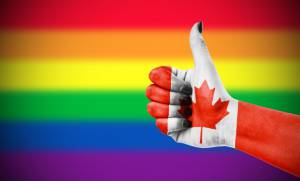The History of Gay Marriage in Canada
 The United States Supreme Court heard arguments on the legality of same-sex unions on April 28. It is a long time coming, and the gay marriage movement has steadily been gaining support south of the border. Thirty-seven states in the U.S. allow same-sex weddings, but they are still banned in 13 others. In 2005, the Canadian Supreme Court ruled gay marriage was legal throughout the nation.
The United States Supreme Court heard arguments on the legality of same-sex unions on April 28. It is a long time coming, and the gay marriage movement has steadily been gaining support south of the border. Thirty-seven states in the U.S. allow same-sex weddings, but they are still banned in 13 others. In 2005, the Canadian Supreme Court ruled gay marriage was legal throughout the nation.
Legal Ruling in Favor of Gay Marriage
Canada was the fourth country after the Netherlands, Belgium and Spain to permit same-sex unions. Prior to the Supreme Court of Canada’s decisive ruling on the issue on July 20, 2005, eight of the 10 provinces and one of the three territories had already legalized it. Ontario was the first province to sanction same-sex unions and did so on June 10, 2003.
Major Events and Milestones
Canada has a long and varied history on gay rights and same-sex unions.
1965
Northwest Territories resident Everett Klippert admitted to having sexual relations with men over a period of two decades. He was deemed an “incurable homosexual,” labeled a “dangerous sex offender,” and sent to jail in 1967. The Canadian Supreme Court endorsed his imprisonment in controversial 3–2 vote.
1967
Justice Minister, and future Prime Minister, Pierre Trudeau proposed legislation that would soften anti-homosexuality laws.
1969
Homosexual is decriminalized when Trudeau’s amendments are passed.
1971
Everett Klippert is released from prison.
Feb. 5, 1981
Over 300 men were arrested in Toronto after police raided gay bath houses. The next evening, more than 3,000 people march to protest the arrests.
1985
In 1985, The “Equality for All” report is released by Parliament’s Committee on Equality Rights. The committee members expressed dismay at the treatment of many Canadian homosexuals including discrimination, harassment, abuse and hate propaganda. They proposed the Canadian Human Rights Act be altered to make discrimination against individuals due to their sexual orientation a crime. The following year, the government issues the “Toward Equality” paper stating, “The government will take whatever measures are necessary to ensure that sexual orientation is a prohibiting ground of discrimination in relation to all areas of federal jurisdiction.”
1988
British Columbia politician Svend Robinson announced he is homosexual. He is the first MP to do so and is re-elected for the eighth time the following year.
1992
In August of 1992, the Ontario Court of Appeals ruled sexual orientation should be included in the Canadian Human Rights Act and any failure to do is prejudicial. Later in the year, the ban on gays in the military is ended by the federal courts.
1999
A May ruling by the Canadian Supreme Court grants homosexual couples the same access to social program benefits to which they contribute as heterosexual common-law couples. Despite this ruling and the resulting changes to numerous laws to comply with it, Parliament votes by a wide margin to keep the definition of “marriage” as the union of two people of the opposite sex.
June 10, 2003
On June 10, 2003, Toronto couple Michael Leshner and Michael Stark are wed after the Ontario Court of Appeals upholds a lower court decision permitting gay marriages.
July 20, 2005
Bill C-38 is passed officially legalizing same-sex unions across Canada.
7, 2006
Conservatives attempt to continue the discussion on the legality of gay marriage and the measure is defeated in the House of Commons by over 50 votes.
Famous Gay Canadians
There are number of well-known gay Canadians including:
- K.D. Lang – Musician
- Kathleen Wynne – First openly homosexual premier
- David Furnish – Writer, film director, producer, and husband of Elton John
- Rick Mercer – TV host and comedian
- Rex Harrington – National Ballet of Canada former principal dancer
Canada has been one of the most progressive countries in the world on gay rights and gay marriage. It remains to be seen if the United States will follow suit.

